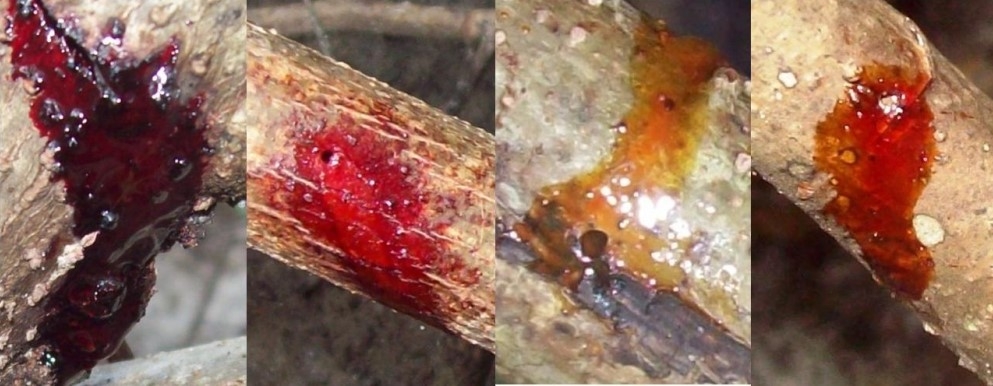

The new species of beetle in the family Buprestidae was found in the state of Bahia and described by researchers at the University of São Paulo and collaborators. The group discovered how the insect contributes to production of red propolis by honey bees (photos: Jean Carvalho)
The new species of beetle in the family Buprestidae was found in the state of Bahia and described by researchers at the University of São Paulo and collaborators. The group discovered how the insect contributes to production of red propolis by honey bees.
The new species of beetle in the family Buprestidae was found in the state of Bahia and described by researchers at the University of São Paulo and collaborators. The group discovered how the insect contributes to production of red propolis by honey bees.

The new species of beetle in the family Buprestidae was found in the state of Bahia and described by researchers at the University of São Paulo and collaborators. The group discovered how the insect contributes to production of red propolis by honey bees (photos: Jean Carvalho)
By Thais Szegö | Agência FAPESP – Jairo Kenupp Bastos first heard about the insect while visiting Canavieiras on the south coast of Bahia, a state in the Northeast of Brazil. “Local beekeepers told me about a tiny beetle that made holes in a plant called Dalbergia ecastaphyllum [Coinvine], a member of the pea family, and that the holes leaked a resin used by bees to make red propolis,” said Bastos, a professor of pharmacognosy (the study of drugs isolated from natural sources, such as plants, animals and minerals) at the University of São Paulo’s Ribeirão Preto School of Pharmaceutical Sciences (FCFRP-USP) in Brazil.
Honey bees (Apis mellifera) harvest the resin and blend it with wax, pollen and enzymes to make red propolis, the second most widely produced and marketed type of propolis in Brazil. Its red color derives from the resin. It has anti-oxidant, anti-inflammatory and anti-tumor properties.
To understand more about the process, Bastos took several larvae of the beetle to the Zoology Museum in São Paulo city, where he was told that adult specimens were needed to identify the insect properly. He invited PhD candidate Letizia Migliore to carry out the mission by going into the countryside outside Canavieiras in search of the plant with its beetles. She was accompanied by Gianfranco Curletti, an entomologist affiliated with the Civic Museum of Natural History in Carmagnola, Italy; Gari Ccana-Ccapatinta, a postdoctoral fellow at FCFRP-USP; and Jean Carvalho, a biologist and beekeeper who lives in Canavieiras.
“The beetle is very small, so it was no easy task, but we managed to collect a few males and females, which were fixed in ethanol at 70% and taken to the museum, where they were analyzed under a microscope. This is how we discovered this new species in the family Buprestidae, which was named Agrilus propolis,” Migliore recalled.
Curletti, Gabriel Biffi and Sônia Casari, head of the museum’s Coleoptera Lab and Migliore’s supervisor, also took part.
“In parallel with this, phytochemical analysis was performed in the Pharmacognosy Lab [at FCFRP-USP] to confirm that the resin and propolis had the same chemical composition, proving their botanical origin and showing that this new species of beetle contributes to the production of the medicinal substance,” said Ccana-Ccapatinta, who is a member of Bastos’s team.
Transformation
The two groups’ combined research offers an overview of the process. Beetle larvae develop inside stems of D. ecastaphyllum, and on reaching adulthood emerge through holes, together with the resinous exudate.
The researchers’ findings are reported in an article published in The Science of Nature. They were funded by FAPESP via a Thematic Project led by Bastos, and a doctoral scholarship awarded to Jennyfer Mejía, a co-author of the article.
“The article is extremely important because it shows that the agent that induces the host plant to produce the key ingredient in red propolis has finally been identified. Until now we had no information on the species of insect that could be behind this phenomenon,” Casari said, adding that the data serves as a basis for further research on the production of red propolis, which sells for a high price and therefore has economic significance. A kilo was worth USD 150 on the market in 2019, when the research was done.
The article “A new species of jewel beetle (Coleoptera, Buprestidae, Agrilus) triggers the production of Brazilian red propolis” is at: link.springer.com/article/10.1007/s00114-022-01785-x.
Republish
The Agency FAPESP licenses news via Creative Commons (CC-BY-NC-ND) so that they can be republished free of charge and in a simple way by other digital or printed vehicles. Agência FAPESP must be credited as the source of the content being republished and the name of the reporter (if any) must be attributed. Using the HMTL button below allows compliance with these rules, detailed in Digital Republishing Policy FAPESP.





